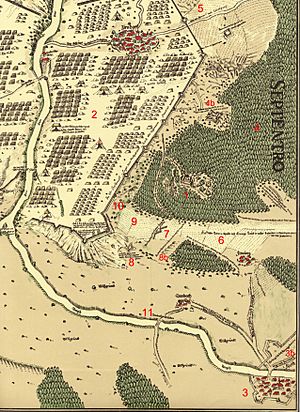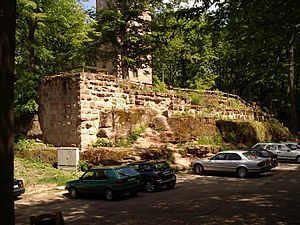Battle of the Alte Veste facts for kids
Quick facts for kids Battle of Alte Veste |
|||||||
|---|---|---|---|---|---|---|---|
| Part of the Swedish intervention in the Thirty Years' War | |||||||
 A map of Wallenstein's camp from 1634. West is at the top. |
|||||||
|
|||||||
| Belligerents | |||||||
| Commanders and leaders | |||||||
| Strength | |||||||
| 43,500 men | 44,600 men 30,011 infantry in 37 regiments and 306 companies. 15,419 cavalry in 39 regiments and 263+ companies |
||||||
| Casualties and losses | |||||||
| 900 | 2,500 | ||||||
The Battle of the Alte Veste was an important fight during the Thirty Years' War. It took place near the city of Nürnberg in 1632. This battle was a clash between the Swedish army and the Imperial army.
Contents
What Led to the Battle?
In the summer of 1632, the army of Swedish King Gustavus Adolphus was near Nürnberg. He faced the army led by Albrecht von Wallenstein.
Why Wallenstein Returned
King Gustavus Adolphus had won many battles. His victories, especially against General Tilly, worried Emperor Ferdinand II. The Emperor decided to ask Albrecht von Wallenstein to return to military service. Wallenstein was very good at gathering soldiers. In just a few weeks, he had a new army ready to fight.
Armies Gather Near Nuremberg
Wallenstein moved his army to stop the Swedes near Nuremberg. His army grew larger as he marched. King Gustavus Adolphus often prepared his army for battle. He challenged Wallenstein to leave his strong camp and fight. But Wallenstein refused to come out.
Supplies Running Low
As time passed, the Swedish army started running out of food and supplies. King Gustavus Adolphus became very impatient. He knew he had to do something to get his army moving again.
The Fight at Alte Veste
King Gustavus Adolphus decided to attack Wallenstein's camp. The camp was located at a place called the Alte Veste, which means "Old Fortress." This was an old, ruined castle on top of a wooded hill.
Attacking the Fortress
If the Swedes could capture the Alte Veste, their cannons could fire down on Wallenstein's camp. This would give them a big advantage. However, the Imperial soldiers were ready. They had built deep trenches and set up an abatis. An abatis is a barrier made of sharpened tree branches. These obstacles made it very hard for the Swedish soldiers to advance.
Swedish Struggles
The Swedish attack struggled against these defenses. Even their best fighting groups had trouble moving forward. Many cavalry (soldiers on horseback) had to get off their horses to fight on foot.
Wallenstein's Counterattack
Wallenstein saw a chance to strike back. He sent his own cavalry out of the camp. They attacked the tired Swedish troops. It was a very dangerous moment for the Swedes. Only when the Swedish cavalry reserve joined the fight did they avoid a complete disaster.
What Happened Next?
The Swedish army was defeated at the Alte Veste. They had lost the battle.
Prisoners and Retreat
The commander of the Swedish artillery, Lennart Torstenson, was captured. He was held prisoner for almost a year. After several weeks, Wallenstein's army also started to run out of supplies. He decided to leave his camp and move north. This allowed the Swedish army to finally leave Nuremberg. The two armies would meet again about two months later. This next battle was the Battle of Lützen. Sadly, King Gustavus Adolphus was killed in that battle.


